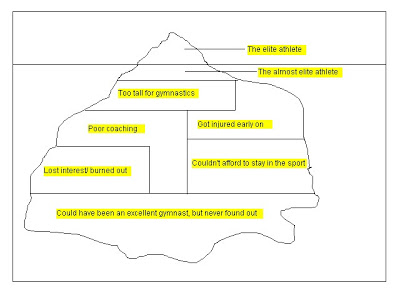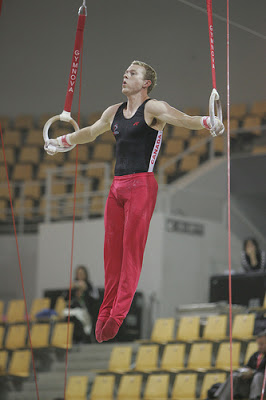Gymnastics makes you short.
Bias. It’s everywhere. But one of the most annoying biases I’ve seen in a lot of the popular fitness publications, including websites, blogs, as well as paper magazines is what I call the “sport causality bias”, or “elite athlete selection bias”.
You’ve seen it. You’ve read it. If you want to get jacked, you should sprint, because elite sprinters are buff, compared to the long distance runners who are scrawny. If you want to protect your knees, you should wear knee sleeves because none of the big-time powerlifters who use knee sleeves have developed knee problems. You don’t need to train with weights; just look at how jacked and ripped gymnasts are, and they just use their body weight.
However, by the same logic, if you want to be tall, then you should play basketball, because all of those basketball player are SO tall! And forget about being tall if you’re going to do gymnastics–gymnastics must cause shortness because all the really good ones are short. And lawn bowling…well that must cause premature aging.
So why is it that the paragraph just above this one sounds so ludicrous, while the paragraph above it, which includes real-life examples of explanations/justification for training methods that are not only used in real-life, but also accepted by perfectly normal-thinking individuals?
The thing about becoming an elite athlete is that, when you really sit down and think about all the factors that need to come together, training, and even what I like to term as “blatant” genetics (the aspects of the genetic profile that contributes DIRECTLY to performance, like VO2max, or lung volumes, muscle fibre distribution, etc) play only a fraction of a role in determining who becomes, and who doesn’t become part of the group of elite athletes upon which we make these broad generalizations (and false causal associations).
With the exception of a minority of sports (rowing, bobsled, luge come to mind), to become an elite or professional athlete requires fairly early entry into a sport. Which means there’s a finite amount of time to reach that elite level. In fact, the countdown begins shortly after you’re born.
Genetics aside, for now, you need to be born into an environment (and there will always be exceptions) where you have proper early nutrition, and developmental tools. This is why so much fuss is made about playing Mozart to infants and having weird black and white mobiles over the bed. A future potential elite athlete could easily be thwarted with an early vitamin D deficiency. And some of these factors aren’t even under anyone’s control (like rheumatic fever, or an unfortunate encounter with another disease, or tragic trauma). But, the odds are slim that you’ll end up as one of these unfortunate children–most infants grow up to be healthy children these days. So let’s say our future athlete makes it through infancy unscathed.
Childhood is where the most random factors needs to fall into place. Let’s say that you have the perfect genetic profile to be the best tennis player EVER. Think about the random factors that need align for this to happen. Firstly, you (or your parents) need to have the idea to expose you to tennis, as opposed to something else. Secondly, you need to have the opportunity to gain that exposure (say, tennis lessons). Thirdly, you need to catch the right kind of environment where you’re going to LIKE tennis (e.g. a talented child with a horrible experience is going to walk away). Fourthly, you need to be in an environment where you have the means to continue training (e.g economic access). Fifthly, you need to be in an environment where you are facilitated to participate (e.g. supportive parent(s), supportive coach, functional school environment). Sixthly, you need to be in an environment where the training your receive will nurture your abilities to the point where you are competitive (e.g. good genetics, bad training = reduced chance of success). Seventhly, you need to avoid early injury. Eighthly, you need to avoid youth burnout and stay interested in your sport. The list goes on. I haven’t even touched on nutrition, coordinative development, team dynamics and the myriad of factors that cause drop-out by youth athletes in their sport, DESPITE the fact that they may be genetically EXCELLENT.
With the exception of Australia, and China (and perhaps a few other countries), talent-identification programs do not exist on a wide-scale level to identify children who might be promising sprinters/runners/gymastics/lifters/football players/etc. So, when we say that a certain body habitus is associated with a certain type of training, we’re looking at not only a genetically elite (you can only excel at the elite level if you have a favourable genetic profile towards that sport and body habitus), but we’re looking at the habitus that is selected for by the sport in the available population of people who HAPPENED to stumble into their sport. So when we think about a sport like gymnastics and start making assumptions about how body-weight exercises or “cross-fit”-style training and body-type results, what we’re doing is making conclusions based on the tip of a complicated iceburg (the one below is by no means complete–apologies for the small font. I couldn’t fix it.) and not taking into consideration, all of the other people who have been exposed to gymnastics who haven’t achieved the classic gymnast-type body:
All of the people in the iceberg have the genetic potential to be elite gymnasts. And with the exception of the very bottom of the iceberg, have all been exposed to gymnastics training. But only the ones at the tip are the ones that the public really gets to see; and subsequently, the ones that have conclusions drawn about what kind of body is possible with a gymnastics style of training. In other words, the idea that gymnastics training produces this:
is based entirely on only the tiniest fraction of the actual population that has been exposed to that type of training. And we all know what happened to the big ship that didn’t know 90% of an iceberg is actually under the water (think about how we could all have been spared Leonardo DiCaprio and that wailing Celine Dion song!)
You might ask, “Why is this guy making such a big deal about this?”
Again, this goes back to the blog-theme of “good idea, poor reasoning.” What I’m NOT saying is that body-weight training, gymnastics, or “cross-fit” style training is a poor training method. But what I am saying is that if we’re going to propose that these styles of training (or any style of training for that matter, whether it’s plyos, or the new-fangled 300 fad) are useful, we should be looking for other, less biased reasons as to why they are useful. If someone gave you a drug and said that it would cure your cancer, based on all the cancer survivors who took the drug, I’m pretty sure you’d be curious about all the people who got the same drug who didn’t survive (and potentially were killed due to a drug complication!) So why are we so ready to accept the idea that a certain body-type is caused by a certain type of training, when all we’re looking at (in this line of reasoning) is the people who are good and have excelled at it (i.e. the tip of the iceberg)?

